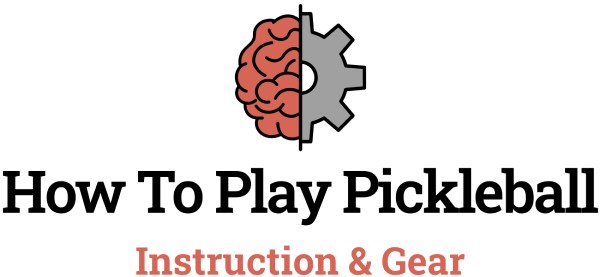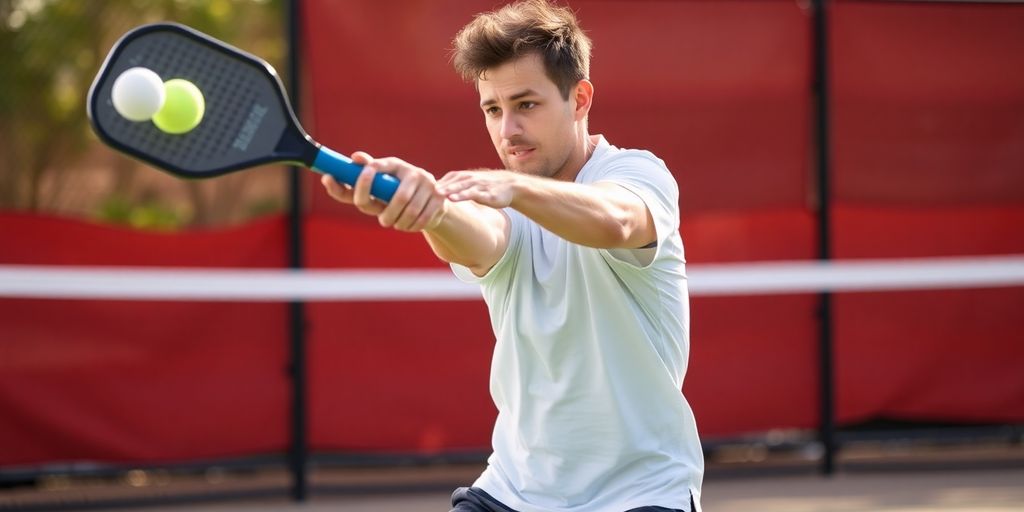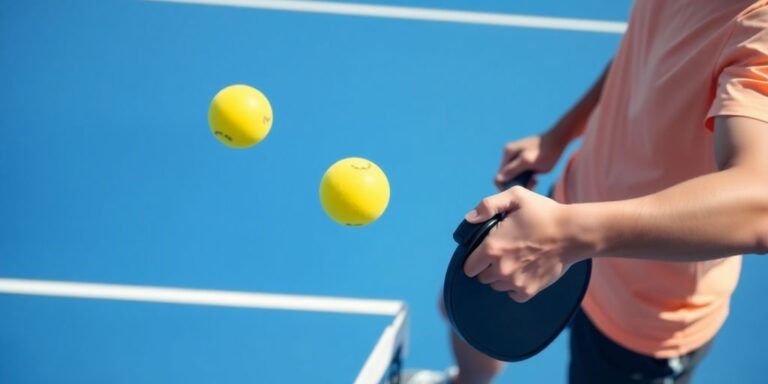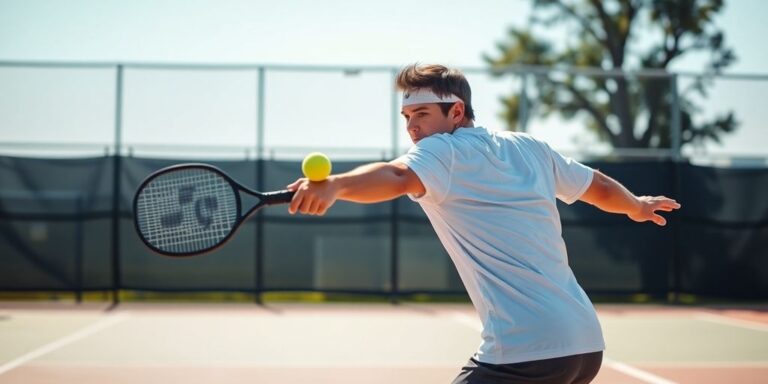If you’re diving into the world of pickleball, you might have heard about the spin serve. It’s a technique that can really change the game, but what exactly is a spin serve in pickleball? In this article, we’ll break down what it is, how to do it legally, and some tips to help you master this skill. Whether you’re a beginner or looking to sharpen your skills, understanding the spin serve can give you a competitive edge.
Key Takeaways
- A spin serve involves applying topspin or underspin to the ball during a serve.
- Legal serving requires the paddle to be below the wrist at contact and to hit the ball below the waist.
- Practicing the right grip and paddle angle is crucial for effective spin application.
- Common mistakes include pre-spinning the ball and incorrect paddle motion.
- Recent rule changes ban pre-spinning the ball before serving, but spin can still be applied with the paddle.
Understanding The Spin Serve In Pickleball
Definition Of A Spin Serve
Okay, so what is a spin serve in pickleball? Basically, it’s when you hit the ball during your serve in a way that makes it rotate. This rotation affects how the ball travels through the air and how it bounces when it lands. It’s not just about hitting the ball hard; it’s about applying a specific type of spin to gain an advantage. The goal is to make the serve more difficult for your opponent to return, either by causing an unusual bounce or by forcing them to react quickly to the ball’s movement. It’s a pretty cool technique when you get it right, but it takes practice.
Types Of Spin: Topspin And Underspin
There are two main types of spin you’ll hear about: topspin and underspin. Topspin is when the ball rotates forward in the direction it’s traveling. This makes the ball dip faster and bounce higher. Underspin (also called backspin) is the opposite; the ball rotates backward. This makes the ball float a bit more and bounce lower. Here’s a quick breakdown:
| Spin Type | Rotation | Effect on Trajectory | Effect on Bounce |
|---|---|---|---|
| Topspin | Forward | Dips Faster | Higher Bounce |
| Underspin | Backward | Floats More | Lower Bounce |
Choosing which spin to use depends on what you’re trying to achieve. Topspin can be great for aggressive serves that you want to land deep, while underspin can be useful for short, tricky serves. Understanding the difference is key to mastering the pickleball serve.
Effects Of Spin On Ball Trajectory
Spin dramatically changes the ball’s path. Topspin causes the ball to drop more rapidly, allowing you to hit with more net clearance while still landing the ball in bounds. Underspin, on the other hand, creates lift, making the ball float and travel further. This can be useful for pushing your opponent back or creating a softer, harder-to-attack shot. The amount of spin you impart also affects the severity of these effects. More spin equals a more pronounced change in trajectory. It’s all about finding the right balance and enhance your pickleball serve for the situation.
Mastering spin is not just about power; it’s about control and deception. A well-placed spin serve can disrupt your opponent’s rhythm, force errors, and ultimately give you the upper hand in the game. It’s a skill that separates good players from great ones.
Legal Requirements For A Spin Serve
Key Rules For Serving
Okay, so you want to add some spin to your serve? Cool! But first, gotta make sure you’re doing it by the book. The most important thing to remember is that you can’t use your hand to create spin before you hit the ball. That’s a big no-no now. You have to impart all the spin with the paddle itself. Also, remember the basic serving rules still apply. You have to serve underhand, contacting the ball below your waist, and your paddle needs to be moving in an upward arc. Think of it like you’re scooping the ball up and over the net. If you are unsure about the pickleball rules, it’s always a good idea to check the official guidelines.
- Serve underhand.
- Contact the ball below the waist.
- Paddle must move in an upward arc.
It’s easy to get caught up in trying to add a ton of spin, but don’t forget the fundamentals. A legal serve that lands in is always better than a super spinny serve that goes out. Focus on consistency and accuracy first, then add the spin.
Understanding The Volley Serve
Let’s talk about the volley serve, because it’s related to the spin serve rules. The volley serve is where you drop the ball and hit it after it bounces. Now, with the new rules, you can’t add spin with your hand on any serve, including the volley serve. Some players may have questions about the new pickleball rules for 2025. The key thing is that the spin has to come from the paddle. If you only have one hand, you can use your paddle to release the ball.
The Role Of Paddle Positioning
Paddle positioning is everything when it comes to creating spin legally. The angle of your paddle face at contact, and the direction you move the paddle, will determine the type and amount of spin you get. For topspin, you’ll want to brush up and over the ball. For sidespin, you’ll brush across it. Experiment with different angles and motions to see what works best for you. Remember, the USA Pickleball Rulebook Change Document is your friend if you’re unsure about anything. It’s all about finding that sweet spot where you can generate spin without breaking the rules. Also, keep in mind that the receiver will be the one calling you out if they think you’re pre-spinning the ball, so make sure your serve is clean!
Techniques To Master The Spin Serve
Grip And Paddle Angle
Getting a handle on the grip and paddle angle is super important for a good spin serve. It’s not just about holding the paddle; it’s about how you hold it. Experiment with different grips to see what feels most natural and gives you the best control. A continental grip is often recommended, but don’t be afraid to tweak it. The paddle angle at contact dictates the type of spin you impart. A slightly closed face helps generate topspin, while an open face can create underspin. It’s all about finding that sweet spot.
Timing And Contact Point
Timing is everything, right? With spin serves, it’s even more true. You need to sync your paddle swing with the ball’s drop or bounce perfectly. The contact point is equally important. Hitting the ball slightly off-center is what creates the spin. For topspin, you’ll want to brush up and through the back of the ball. For underspin, you’ll cut down and under it. It takes practice to get the feel for it, but once you do, it becomes second nature. Remember, a smooth grip is key to controlling the ball’s trajectory.
Practicing Spin Application
Okay, so you know the theory, now it’s time to put it into practice. Don’t expect to master the spin serve overnight; it takes time and repetition. Start by practicing the motion without even hitting the ball, just to get the feel for the swing and paddle angle. Then, move on to hitting the ball, focusing on applying the spin. Use targets to help you visualize where you want the ball to go. And don’t get discouraged if you mess up a lot at first. Everyone does! Keep at it, and you’ll start to see improvement. Remember, mastering spin can really up your game.
I remember when I first started trying to learn the spin serve. It was so frustrating! I couldn’t get the hang of it, and my serves were either going into the net or flying way out of bounds. But I kept practicing, and eventually, it clicked. Now, it’s one of my go-to serves, and it’s helped me win a lot of points.
Common Mistakes When Executing A Spin Serve

Pre-Spinning The Ball
One of the biggest changes in pickleball serving recently involves pre-spinning the ball. It’s now illegal to impart spin to the ball with your hand before you actually hit it. This used to be a common technique to add extra sauce to your serve, but those days are gone. Players often forget and revert to old habits, so it’s something to really focus on eliminating. It’s easy for your opponent to call you on it, and it’s a fault every time. This rule change has definitely changed the game.
Incorrect Paddle Motion
Generating spin is all about the paddle motion. A lot of players struggle with getting the right angle and speed. Here are some common errors:
- Not using enough wrist action: The wrist is key for generating spin. A stiff wrist will kill your spin serve.
- Swinging too slowly: You need paddle speed to create spin. A slow, deliberate swing won’t cut it.
- Not following through: A full follow-through helps impart maximum spin on the ball.
It’s important to remember that the paddle needs to move across the ball to generate topspin or sidespin. Simply hitting the ball straight on won’t do the trick. Think about brushing the ball with the paddle face.
Misjudging Spin Effects
Even if you get the technique right, it’s easy to misjudge how the spin will affect the ball’s trajectory and bounce. This leads to serves that land out of bounds or sit up too high. Here’s what often goes wrong:
- Overestimating the spin: The ball might not curve or drop as much as you expect, especially in windy conditions.
- Underestimating the spin: The ball might kick wildly to the side, surprising both you and your opponent.
- Not accounting for court surface: Different surfaces can affect how the ball bounces and reacts to spin. Adjust your serve accordingly. Understanding spin serves is key to mastering them.
The Impact Of Recent Rule Changes

Overview Of Rule 4.A.5
Okay, so Rule 4.A.5. It’s the one that everyone’s been talking about, especially if you’re into pickleball skill levels. Basically, it addresses the legality of spin serves, particularly those where you add spin to the ball before you even hit it. The core of the rule now prohibits imparting spin on the ball before the serve contact. This means no more of that fancy pre-spinning action some players were using to get a serious edge. The idea is to level the playing field a bit and make the serve more about starting the rally than winning it outright. It’s a pretty big deal, and it’s got people on both sides of the fence, which we’ll get into.
Implications For Players
So, what does this mean for you when you step onto the court? Well, if you were someone who relied on the pre-spun serve, you’re going to have to adjust your game. It’s time to get creative and find new ways to generate spin during your serve motion. This might involve tweaking your grip, paddle angle, or contact point. For those who struggled against the pre-spun serve, this rule change might be a welcome relief. You might find serves are easier to return, and rallies last longer. It could also affect the future of pickleball as players adapt to the new rules.
Here’s a quick rundown:
- Adjust your serving technique if you used pre-spin.
- Expect more consistent serves from your opponents.
- Focus on generating spin during the serve motion.
The goal of this rule change is to promote longer, more engaging rallies. It’s about making the game more accessible and enjoyable for everyone, regardless of their skill level. It also brings pickleball more in line with other racquet sports like tennis and table tennis, where pre-spinning the ball before a serve is not allowed.
Clarifying Legal Spin Application
Let’s be clear: spin isn’t banned from serves, just the pre-spin. You can still use topspin, backspin, or sidespin to make your serve tricky. The key is how you apply that spin. You have to generate it as part of your serving motion, not before. Think about brushing up or down on the ball as you make contact. Experiment with different paddle angles and wrist movements to see what works best for you. Remember, the new pickleball rules are there to guide you, not restrict your creativity. It’s all about finding that sweet spot where you can add spin legally and effectively. It might take some practice, but it’s definitely doable. And who knows, you might even discover a new spin technique that becomes your signature move!
Strategies For Using Spin Serves Effectively
Reading Your Opponent
One of the biggest things to think about is watching your opponent. Pay attention to their weaknesses and adjust your spin serve accordingly. Do they struggle with balls that bounce high? Use topspin. Do they have trouble with balls that die quickly? Try underspin. If they favor their forehand, aim for their backhand with a serve that curves away from them. It’s like a chess match; you’re trying to anticipate their moves and exploit their vulnerabilities. Also, consider their position on the court. If they stand far back, a short, spinny serve might catch them off guard. Understanding your opponent’s tendencies is key to making your spin serve a weapon. You can even find a pickleball coach near you to help you analyze your opponent’s game.
Adjusting Spin Based On Court Conditions
Court conditions can really mess with your spin serve. A wet court will make the ball skid more, while a dry court will allow it to grip and spin more effectively. Wind can also play a big role, affecting the ball’s trajectory. You’ll need to adjust the amount and type of spin you use based on these factors. For example, on a windy day, you might want to reduce the amount of topspin to prevent the ball from sailing long. On a dry court, you can really crank up the spin to make the ball bounce unpredictably. It’s all about adapting to the environment and using it to your advantage. Remember, practice in different conditions to get a feel for how the ball behaves. This will help you make better decisions during a game. Seniors can also benefit from understanding how court conditions affect their game, making pickleball for seniors even more enjoyable.
Combining Spin With Other Techniques
Don’t rely solely on spin. Mix it up! A spin serve is most effective when it’s combined with other techniques, like varying your serve’s depth, speed, and placement. Here’s a few ideas:
- Deep Serve with Topspin: Forces your opponent back and makes the return more difficult.
- Short Serve with Underspin: Catches your opponent off guard and makes the ball die quickly.
- Wide Serve with Sidespin: Pulls your opponent off the court and opens up the middle.
By combining spin with these other techniques, you’ll keep your opponent guessing and make it much harder for them to return your serve effectively. Remember, the goal is to disrupt their rhythm and force them into making errors. Also, consider the legality of your serve. Make sure you are following the rules for a legal pickleball serve.
Varying your serves is key to keeping your opponent guessing. Don’t become predictable. A mix of spin, speed, and placement will make your serve a real weapon. Think about it like this: if you always serve the same way, your opponent will eventually figure it out and be ready for it. But if you keep them guessing, they’ll never be able to get comfortable.
Training Drills For Spin Serve Mastery
Solo Practice Techniques
Okay, so you want to get better at spin serves? Great! When you’re flying solo, focus on repetition and consistency. Start by practicing your grip and paddle angle in front of a mirror to make sure you’re doing it right. Then, grab a bucket of balls and head to the court. Focus on hitting the same spot on the ball each time to generate consistent spin.
- Practice topspin serves by brushing up the back of the ball.
- Work on sidespin by brushing across the side of the ball.
- Experiment with different paddle speeds to see how it affects the spin.
Partner Drills
Partner drills are awesome because you get immediate feedback. Have your partner stand on the opposite side of the court and give you feedback on the serve’s spin and placement. Try to hit specific targets, like their backhand or forehand. You can also work on returning serves with different spins. It’s all about adapting and reacting. Consider joining a local pickleball league to find practice partners.
Incorporating Spin Into Game Play
Alright, now it’s time to put those spin serves to the test in a real game. Don’t be afraid to experiment with different spins and placements to see what works best against different opponents. Pay attention to how they react to your serves and adjust accordingly. Remember, the goal isn’t just to hit a fancy serve, it’s to gain an advantage. Proper pickleball gear maintenance is also important for consistent performance.
It’s easy to get caught up in trying to hit the perfect spin serve, but don’t forget the basics. Make sure your serve is legal and lands in the service box. A legal serve with a little spin is better than an illegal serve with a lot of spin. Focus on consistency and placement first, then add spin as you improve. Also, consider taking a pickleball lesson to improve your skills.
To become a pro at spin serves, practicing the right drills is key. These exercises will help you improve your technique and control, making your serves more effective. Want to learn more about mastering your spin serve? Visit our website for detailed guides and tips!
Wrapping It Up
So, there you have it! The spin serve in pickleball can be a game-changer if you know how to do it right. Remember, you can add spin with your paddle, but not with your hands before the serve. Stick to the rules, practice your technique, and you’ll be surprising your opponents in no time. Whether you’re just starting out or looking to refine your skills, mastering the spin serve can really up your game. So grab your paddle, hit the court, and have fun with it!
Frequently Asked Questions
What is a spin serve in pickleball?
A spin serve is when a player hits the ball with their paddle in a way that adds spin to it. This can make the ball move differently and can confuse the opponent.
Is it legal to use spin in a pickleball serve?
Yes, you can use spin in your serve as long as you apply it with your paddle when you hit the ball, not with your hands or fingers before hitting.
What are the main types of spins used in pickleball?
The two main types of spins are topspin, which makes the ball dip quickly, and underspin, which can make the ball stay low after it bounces.
What should I avoid to execute a legal spin serve?
Avoid pre-spinning the ball with your hand before you hit it. You must hit the ball with your paddle to apply spin legally.
How can I practice my spin serve?
You can practice by working on your grip, paddle angle, and timing. Doing drills alone or with a partner can help you improve.
What changes were made to the serving rules recently?
Recent changes state that you can’t pre-spin the ball with your hand. You must only use your paddle to add spin when you hit the ball.




